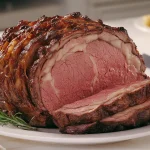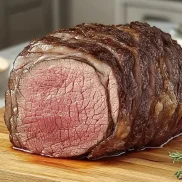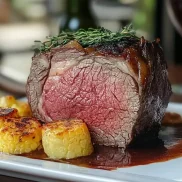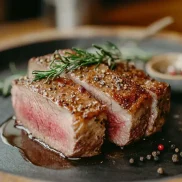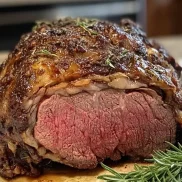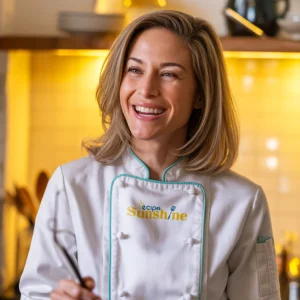Cooking a boneless prime rib to perfection can elevate any meal into a culinary masterpiece. This succulent cut of beef, known for its tender texture and rich flavor, deserves careful preparation to achieve the desired results. But one question always lingers: how long do you cook a boneless prime rib? Whether you’re hosting a festive holiday gathering or preparing a special dinner, understanding the nuances of cooking time is crucial.
In this comprehensive guide, we’ll explore everything you need to know about cooking a boneless prime rib. From selecting the right cut and understanding factors that influence cooking time to mastering techniques for temperature control and doneness, this article covers it all. For a delicious twist, check out this boneless prime rib recipe to elevate your cooking game. By the end, you’ll feel confident in serving a mouthwatering boneless prime rib that impresses every guest at your table.
Table of Contents
Understanding Boneless Prime Rib
What Is Boneless Prime Rib?
Boneless prime rib is a premium cut of beef that comes from the rib section of the cow, specifically the upper rib area. Known for its rich marbling and tender texture, it is often considered one of the most luxurious cuts of beef available. The absence of bones in this cut makes it easier to handle, carve, and cook evenly, which is why many home cooks prefer it over the bone-in version.
Prime rib, as the name suggests, is typically graded as “prime” by the USDA, signifying superior quality in terms of marbling and flavor. However, you may also find it labeled as “standing rib roast” in grocery stores or butcher shops. When the rib bones are removed, it’s called a boneless prime rib, and the meat is usually tied with butcher’s twine to maintain its shape during cooking.
This cut is prized for its ability to retain moisture and flavor while cooking, making it a centerpiece for special occasions such as holidays, weddings, or celebratory dinners. With proper preparation and cooking, the boneless prime rib can deliver an unforgettable dining experience that’s both tender and flavorful.
How It Differs from Bone-In Prime Rib
The primary distinction between boneless and bone-in prime rib lies, of course, in the presence of the rib bones. Bone-in prime rib, also known as a standing rib roast, has the rib bones intact, which some argue contribute additional flavor during the cooking process. The bones act as a natural heat shield, which can help keep the meat moist and tender while providing a rustic, dramatic presentation.
On the other hand, boneless prime rib offers a more streamlined approach. Without the bones, the roast is easier to season and carve, and it tends to cook more uniformly since there are no bones to affect heat distribution. This uniformity makes boneless prime rib an excellent choice for beginners or for anyone looking for a hassle-free preparation process.
While both options are delicious, the choice often comes down to personal preference. Those who value ease of preparation and serving might lean towards the boneless option, while traditionalists who enjoy the robust presentation and subtle bone-enhanced flavors might opt for the bone-in variety.
Choosing the Right Cut for Cooking
When selecting a boneless prime rib for your next culinary adventure, there are a few key factors to keep in mind. First, consider the grade of the meat. Prime grade offers the highest level of marbling and tenderness, but it’s also the most expensive. Choice grade is slightly less marbled but still delivers excellent results for a lower price point.
Next, pay attention to the size and weight of the cut. A general rule of thumb is to plan for about one pound of meat per person, which ensures generous portions while accounting for shrinkage during cooking. If you’re hosting a larger gathering, you might opt for a larger roast to ensure there’s plenty to go around.
Additionally, inspect the cut for consistent marbling—the fine streaks of fat throughout the meat—as this contributes significantly to flavor and tenderness. A well-marbled roast will yield juicy, flavorful results when cooked properly.
Finally, it’s worth consulting your butcher. They can provide valuable advice on selecting a roast that meets your needs and even help with preparations, such as trimming excess fat or tying the roast for even cooking.
By understanding the nuances of boneless prime rib, from its unique characteristics to its differences from the bone-in version, you’ll be well-equipped to select and prepare a cut that promises culinary excellence.
How Long Do You Cook a Boneless Prime Rib? Key Factors to Consider
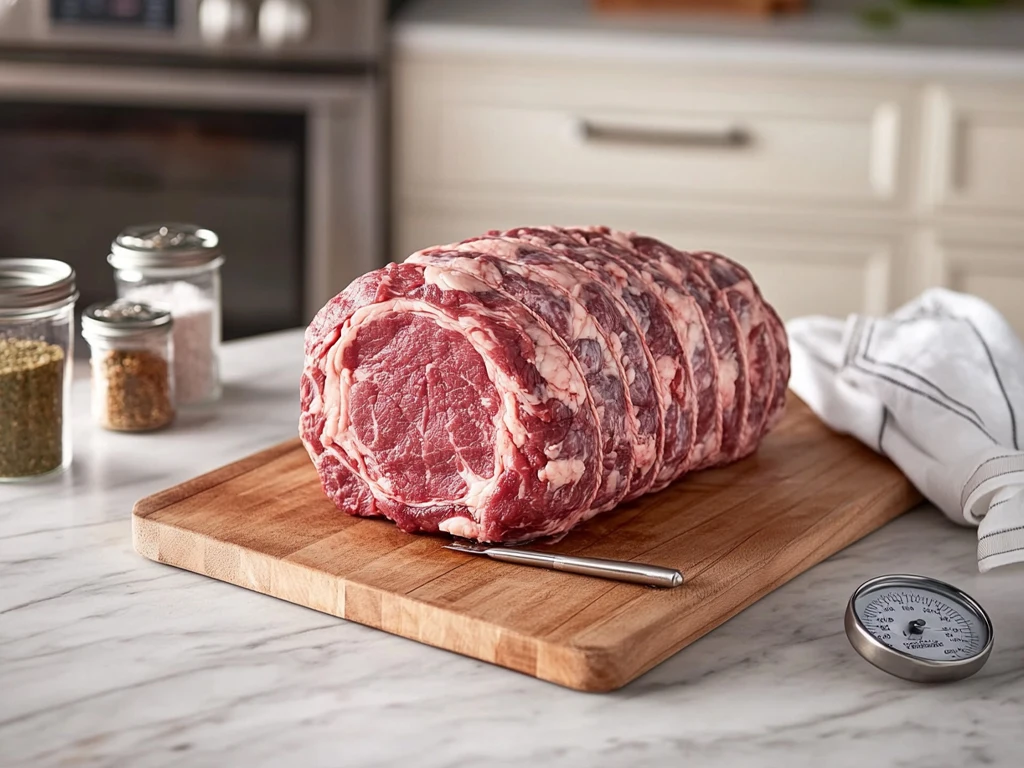
Size and Weight of the Prime Rib
The size and weight of your boneless prime rib are among the most critical factors influencing how long it needs to cook. Larger cuts naturally require more time to cook through, while smaller roasts will cook faster. A general rule of thumb is to allocate approximately 15-20 minutes of cooking time per pound at 325°F for a medium-rare result. For example, a 5-pound roast would take about 1 hour and 15 minutes to 1 hour and 40 minutes, while a larger 8-pound roast might require closer to 2 hours and 40 minutes.
Additionally, the shape of the roast can also play a role. A thicker, more compact roast may take longer to cook than a flatter one, even if the weight is the same. This is because heat takes longer to penetrate the center of a thick roast. It’s crucial to use a meat thermometer to ensure the internal temperature matches your desired level of doneness, rather than relying solely on time.
Oven Type and Settings
Your oven type can significantly affect cooking time. Conventional ovens, which use radiant heat, might cook a bit slower than convection ovens, which use a fan to circulate hot air and cook food more evenly and quickly. If you’re using a convection oven, you may need to reduce the cooking time by about 25% or lower the temperature by 25 degrees Fahrenheit to prevent overcooking.
The oven’s accuracy is another consideration. Some ovens run hotter or cooler than the set temperature, which can alter cooking times. To counteract this, use an oven thermometer to verify your oven’s actual temperature. Preheating the oven is also essential, as placing your prime rib into a cold or improperly heated oven will disrupt cooking times and potentially result in uneven doneness.
Lastly, consider whether you’re using additional cooking aids, such as a roasting pan with a rack. Elevating the roast off the pan allows for better air circulation, promoting even cooking and potentially reducing overall time.
Desired Level of Doneness
Your preferred level of doneness is a key determinant of cooking time. Boneless prime rib is typically served rare to medium-rare to preserve its tender texture and juicy flavor. Here’s a quick reference for internal temperatures:
- Rare: 120°F to 125°F (red center)
- Medium-Rare: 130°F to 135°F (warm red center)
- Medium: 140°F to 145°F (warm pink center)
- Well-Done: 155°F and above (minimal pink)
Cooking times will vary depending on the target internal temperature. For instance, a medium-rare roast will cook faster than a well-done one. To achieve the desired doneness, use a meat thermometer and check the temperature at the thickest part of the roast. Remove the roast from the oven about 5°F below your target temperature, as it will continue to cook while resting.
By understanding how size, oven type, and doneness preferences affect cooking time, you’ll be better equipped to plan and execute a perfectly cooked boneless prime rib every time.
Step-by-Step Cooking Guide
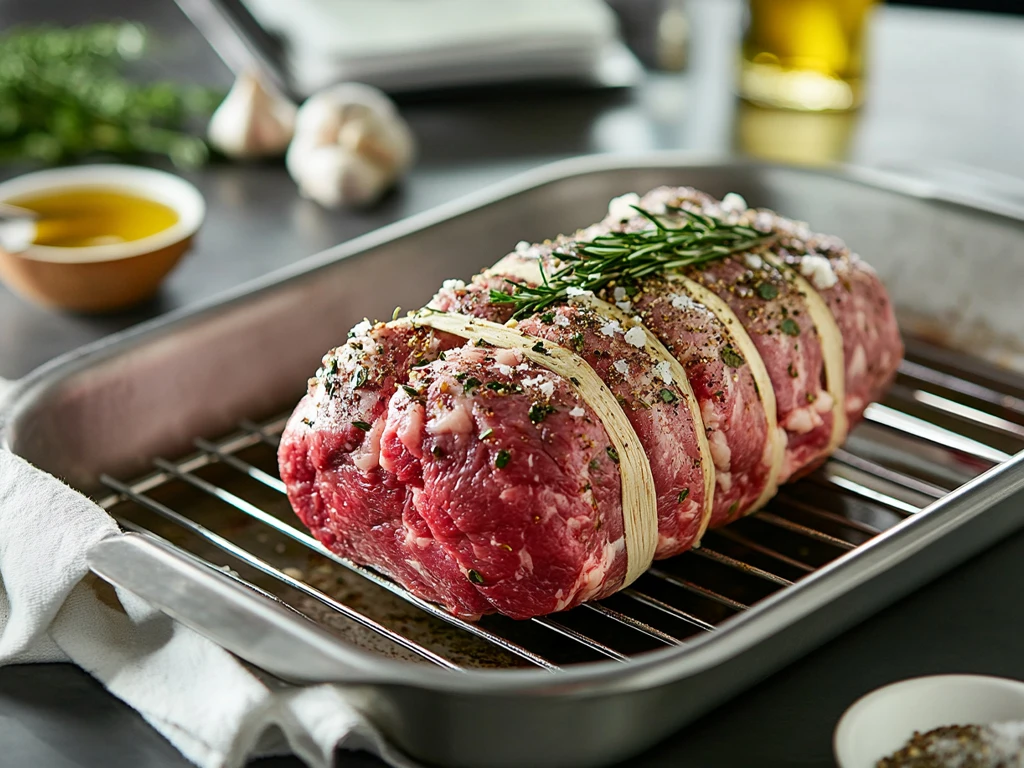
Preparing the Boneless Prime Rib
Trimming and Tying the Meat
Before cooking, it’s essential to prepare your boneless prime rib for optimal results. Start by trimming any excess fat from the roast, leaving a thin layer about ¼-inch thick. This fat layer helps baste the meat as it cooks, enhancing its flavor and keeping it moist. Use a sharp knife to carefully remove any large sections of hard fat or silverskin, as these won’t render down during cooking.
Once trimmed, tie the roast with butcher’s twine at 1- to 2-inch intervals. Tying ensures the roast maintains a uniform shape, which promotes even cooking. A uniformly shaped roast prevents thinner sections from overcooking while the center finishes.
Seasoning Techniques for Optimal Flavor
Seasoning is where your roast begins to take on its mouthwatering flavor. Generously coat the entire surface of the prime rib with kosher salt and freshly cracked black pepper. For a more robust flavor, create a seasoning blend with garlic powder, onion powder, smoked paprika, and fresh or dried herbs such as rosemary and thyme.
For best results, season the roast at least 24 hours in advance and let it rest uncovered in the refrigerator. This dry-brining process allows the salt to penetrate deeper into the meat, enhancing both flavor and tenderness. Before cooking, allow the roast to come to room temperature for about 1-2 hours to ensure even cooking.
Choosing the Right Temperature for Cooking
Low-and-Slow Method
The low-and-slow method involves cooking the roast at a lower temperature for a longer period. This technique is ideal for achieving a consistently tender and evenly cooked prime rib. Preheat your oven to 225°F. Place the roast on a rack inside a roasting pan and cook until the internal temperature reaches about 10°F below your desired doneness. Finish the roast with a high-heat sear at 450°F for 10-15 minutes to develop a crispy, golden crust.
High-Heat Sear Method
Alternatively, the high-heat sear method starts with a blast of heat to create a crust, followed by cooking at a lower temperature. Preheat your oven to 450°F and cook the roast for 20-25 minutes. Then reduce the temperature to 325°F and continue cooking until the internal temperature is just shy of your target doneness. This method is quicker and delivers a beautiful crust but requires close monitoring to avoid overcooking.
Cooking Time Recommendations
Rare: Time and Temperature
For rare doneness (120°F to 125°F internal temperature):
- Cook at 225°F for approximately 20 minutes per pound.
- Sear at 450°F for 10-15 minutes.
Medium Rare: Time and Temperature
For medium-rare doneness (130°F to 135°F internal temperature):
- Cook at 225°F for approximately 22 minutes per pound.
- Sear at 450°F for 10-15 minutes.
Well Done: Time and Temperature
For well-done doneness (155°F and above internal temperature):
- Cook at 225°F for approximately 30 minutes per pound.
- Sear at 450°F for 10-15 minutes.
Using a meat thermometer is essential to ensure accuracy. Insert the thermometer into the thickest part of the roast, avoiding any fat or bone, to get an accurate reading. Always allow the roast to rest for at least 20-30 minutes after removing it from the oven. During this resting period, the internal temperature will rise by 5-10°F, reaching your desired doneness while redistributing juices for a tender, flavorful bite.
Using a Meat Thermometer
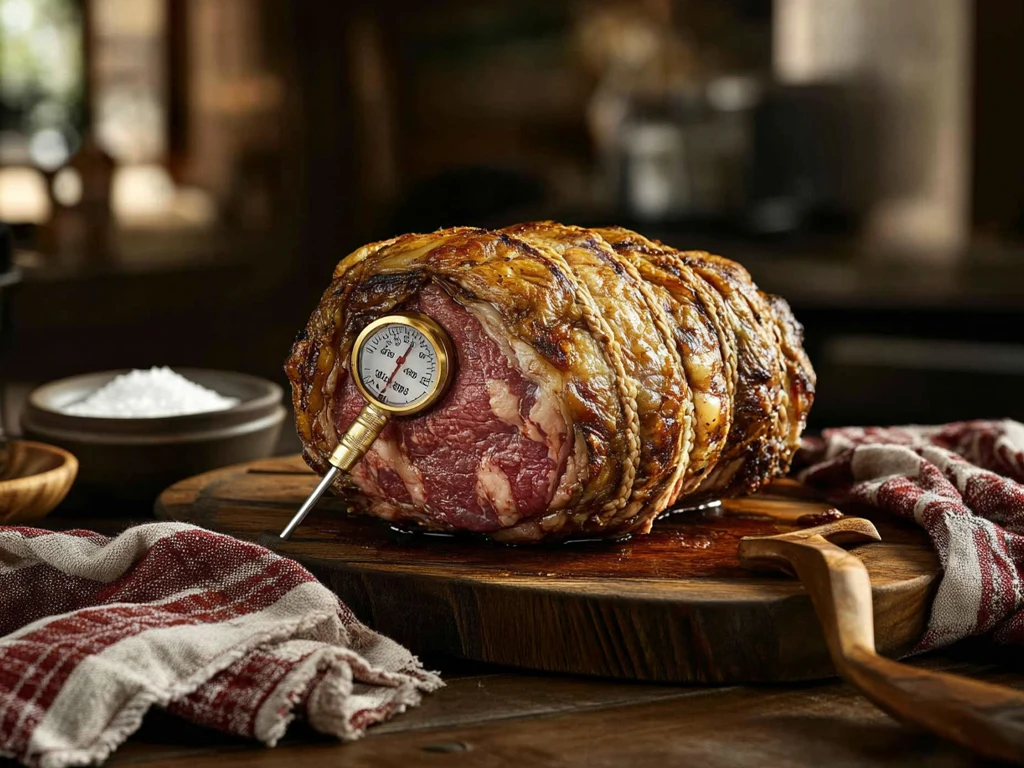
Why It’s Essential for Prime Rib
A meat thermometer is an indispensable tool when cooking a boneless prime rib, ensuring the roast reaches the perfect level of doneness without overcooking. Unlike other cuts of meat, prime rib demands precision to maintain its tender texture and rich flavor. Even slight deviations in temperature can lead to a roast that’s too rare or overdone, leaving guests less than impressed.
Using a thermometer eliminates guesswork and gives you confidence in achieving consistent results every time. By monitoring the internal temperature, you can cook the roast to your preferred level of doneness, whether that’s rare, medium-rare, or well-done. This approach not only preserves the roast’s natural juices but also enhances its flavor, as overcooking can dry out the meat and diminish its taste.
Another advantage of using a meat thermometer is that it helps account for the roast’s natural variability. Factors such as size, shape, and oven performance can all influence cooking time, but a thermometer ensures accuracy regardless of these variables. For best results, invest in a reliable digital or instant-read thermometer that provides fast, accurate readings.
Proper Placement and Timing
Correct placement of the thermometer probe is crucial for obtaining an accurate temperature reading. Insert the probe into the thickest part of the roast, avoiding any fat or connective tissue, which can give false readings. Make sure the thermometer does not touch the roasting pan or any bones (if present), as this can also skew the results.
Timing is equally important when using a meat thermometer. Begin checking the temperature well before the estimated cooking time is up to avoid overcooking. For example, if you’re aiming for a medium-rare doneness, start checking the roast when the internal temperature approaches 120°F. Remember that the roast’s temperature will continue to rise by 5-10°F during the resting period, so it’s best to remove it from the oven slightly below your target temperature.
To ensure accuracy, clean the thermometer probe between uses to avoid cross-contamination or residue buildup that might affect readings. For even more precision, consider leaving the thermometer in the roast during the cooking process (if your thermometer is oven-safe) to monitor real-time temperature changes.
By using a meat thermometer and following these guidelines, you’ll be well on your way to mastering the art of cooking a boneless prime rib that’s tender, juicy, and cooked to perfection.
Resting and Slicing the Meat
Importance of Resting for Juiciness
Resting your boneless prime rib after cooking is a critical step in ensuring the roast remains juicy and flavorful. When meat is exposed to high heat during cooking, its natural juices are pushed toward the outer edges. Resting allows these juices to redistribute evenly throughout the roast, resulting in a moist and tender texture. Skipping this step can lead to a disappointing meal, as slicing too soon will cause the juices to run out, leaving the meat dry.
For optimal results, remove the roast from the oven about 5-10°F below your target internal temperature. This accounts for carryover cooking—the process where the internal temperature of the meat continues to rise as it rests. Tent the roast loosely with aluminum foil to retain warmth without trapping steam, which could soften the crust.
The resting period should last at least 20-30 minutes for larger cuts like boneless prime rib. This timeframe provides sufficient time for the juices to settle and for the roast to cool slightly, making it easier to handle and slice. Resting is a simple yet essential step that guarantees your prime rib will deliver a mouthwatering experience with every bite.
Best Practices for Slicing
Slicing a boneless prime rib correctly is just as important as cooking it properly. The goal is to maintain the roast’s structural integrity while ensuring each slice is tender and evenly portioned. Follow these best practices for flawless slicing:
- Use the Right Tools: Invest in a sharp carving knife or chef’s knife for clean, precise cuts. A carving fork can help steady the roast as you slice.
- Cut Against the Grain: Always slice against the grain of the meat. This shortens the muscle fibers, making each bite more tender and easier to chew.
- Slice to Desired Thickness: For most servings, aim for slices about ¼ to ½ inch thick. Thinner slices are ideal for elegant presentations or smaller portions, while thicker slices work well for heartier servings.
- Keep It Steady: Place the roast on a sturdy cutting board with a groove to catch any residual juices. Ensure the roast is stable by trimming any uneven edges if necessary.
- Serve Immediately: Arrange the slices on a warmed serving platter to keep them hot and present them to guests without delay.
By taking the time to rest and slice your boneless prime rib with care, you’ll enhance both its flavor and presentation. These simple steps ensure that every serving is as tender and juicy as the first, leaving a lasting impression on your guests.
Common Mistakes to Avoid
Overcooking the Prime Rib
One of the most common mistakes when preparing boneless prime rib is overcooking it. This luxurious cut of meat is prized for its tender, juicy texture, which is best preserved when cooked to perfection. Overcooking not only dries out the meat but also diminishes its natural flavors, leaving you with a roast that’s less than satisfying.
To avoid this pitfall, always use a reliable meat thermometer to monitor the internal temperature of the roast. Begin checking the temperature well before the estimated cooking time is complete, especially if you’re aiming for rare or medium-rare doneness. Removing the roast from the oven slightly below your target temperature—to account for carryover cooking—is another effective strategy.
Additionally, avoid the temptation to cook the roast at excessively high temperatures throughout the process. While high-heat searing can create a delicious crust, prolonged exposure to intense heat can lead to uneven cooking and an overdone interior. Stick to recommended temperatures and methods, such as the low-and-slow technique, to ensure consistent results.
Not Letting the Meat Rest
Failing to rest your prime rib after cooking is a critical error that can ruin an otherwise perfectly cooked roast. When the meat is hot out of the oven, its juices are concentrated near the surface due to the cooking process. Cutting into the roast immediately causes these juices to escape, leaving the meat dry and less flavorful.
To prevent this, always let your prime rib rest for at least 20-30 minutes before slicing. This rest period allows the juices to redistribute evenly throughout the meat, resulting in a tender and moist roast. Tenting the meat loosely with aluminum foil helps maintain its warmth while avoiding excessive steaming that could soften the crust.
Using Inaccurate Cooking Equipment
Inaccurate or unreliable cooking equipment can lead to significant issues when preparing a boneless prime rib. For instance, ovens that run too hot or too cold can throw off your cooking times, potentially leading to an overcooked or undercooked roast. Similarly, low-quality meat thermometers might provide inaccurate readings, causing you to misjudge the doneness of your roast.
To avoid these problems, regularly calibrate your oven and invest in a high-quality digital meat thermometer. An oven thermometer can also help verify that your oven is heating to the correct temperature. Additionally, ensure that your roasting pan and rack are sturdy and well-suited to support the size of your prime rib for even cooking.
By steering clear of these common mistakes, you’ll set yourself up for success and ensure that your boneless prime rib is a show-stopping centerpiece for any occasion.
Frequently Asked Questions
Is boneless prime rib roast the same as prime rib?
No, boneless prime rib roast and prime rib are not exactly the same, although they come from the same part of the cow. Prime rib typically refers to a standing rib roast, which includes the rib bones. A boneless prime rib roast, on the other hand, has had the rib bones removed for easier carving and more even cooking. While the flavors are similar, the cooking techniques and presentation may vary depending on whether the rib bones are included. Learn more
What is the 500 rule for prime rib?
The 500 rule is a cooking method used to simplify the process of roasting prime rib. It involves cooking the roast at 500°F for a set amount of time—approximately 5 minutes per pound—and then turning off the oven. The roast remains in the closed oven for 2 hours without opening the door. This method relies on residual heat to finish cooking the meat and is favored for its ability to produce a well-seared crust and tender interior. Learn more
How do I know when my prime rib is done?
The best way to determine doneness is by using a meat thermometer. Insert the thermometer into the thickest part of the roast, avoiding fat or bone. Internal temperatures for doneness are as follows:
- Rare: 120°F to 125°F
- Medium-rare: 130°F to 135°F
- Medium: 140°F to 145°F
- Well-done: 155°F and above
Can I cook a boneless prime rib roast from frozen?
Yes, you can cook a boneless prime rib roast from frozen, but it requires additional cooking time. Plan to increase the roasting time by about 50% compared to a thawed roast. However, for the best results in terms of flavor and texture, it’s recommended to thaw the roast in the refrigerator for 24-48 hours before cooking.
What’s the difference between prime grade and choice grade?
Prime grade is the highest quality designation given by the USDA, indicating superior marbling, tenderness, and flavor. Choice grade is slightly lower in marbling but still delivers excellent results, often at a more affordable price point. Both grades are suitable for prime rib, but prime grade is ideal for achieving a luxurious dining experience.
Can I grill or smoke a boneless prime rib roast?
Absolutely! Grilling or smoking a boneless prime rib roast adds a unique flavor profile. For grilling, use indirect heat and cook until the desired internal temperature is reached. For smoking, maintain a consistent temperature of 225°F to 250°F and use hardwoods like oak or hickory for a smoky flavor. Always use a meat thermometer to ensure the roast is cooked to your preferred doneness.
Conclusion
Mastering the art of cooking a boneless prime rib doesn’t have to be intimidating. By understanding the factors that influence cooking time, using reliable tools like a meat thermometer, and avoiding common mistakes, you can create a roast that’s tender, juicy, and full of flavor. Whether you prefer the low-and-slow method or a high-heat sear, the key is precision and care in every step of the process.
This guide has walked you through the essential elements of preparing a boneless prime rib, from selecting the perfect cut to resting and slicing it like a pro. With these tips in hand, you’re ready to impress your guests with a show-stopping centerpiece that’s both delicious and memorable. Enjoy your culinary success, and don’t forget to savor every bite of your perfectly cooked prime rib!

